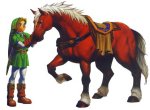Transportation in videogames is often a feature that, if done properly, passes unremembered and it forms inevitably part of the resulting game. Before games had to worry about production values, the journey was normally the game itself, and the means would generally play along to create the experience. Running through a level, jumping and shooting was what it took to take you from one level to another.
With time transportation has settled itself as one of the key features inside a game and in many games the amount of time moving from one place to another absorbs most of gameplay time. It is impossible not to mention DMA/Rockstar´s GTA series which has always been heavily vehicle based. Before GTA 3 came around GTA´s structure was heavily vehicle oriented, with most of its missions taking place behind (or over) a wheel. In time it has been implemented as an unavoidable trend of GTA; but it is also just one more element in it. Red Dead Redemption´s horses are a master move to the introduction of transportation in a video game, working with the game for ambient and feel. Riding alone in the empty areas of the game was found more tedious for gamers more avid of quick emotions, but those that love a good scenario and ambience (and the old westerns…) find it a defining moment in that game when you first sit on a horse and ride it.
The rpg transportation model is one of the most classical means of transportation between areas. With the exception of Elder Scrolls and similar, RPGs generally offer a fancy vehicle that is only of use to get you quickly (via a loading screen) around the different areas. In fact, it might be one of the weakpoints of some newer RPGs such as Dragon Age: an epic game with a promising world that you would only get a glimpse at really (without mentioning the sequel´s stagnancy) and that many players actually wished to walk around and explore. Of course, the other side of the coin is create those journeys but put nothing in them that will interest the players (Fable II anyone?). Far Cry 2 was a very interesting game and had great ideas, but 70% of the game was driving a car from one point of the map to another, visiting the same respawning checkpoints over and over again, which eventually weighed on the experience.
Superhero games are the ones were the means with which you move around the map matters most… for good and bad. Anyone that played Superman 64 will detest having to grab a character that flies… but if you ever got a chance to try Spiderman 2 in its day, you might feel that some games are just worth to see the main character moving and, more importantly, controlling him. Spiderman 2 was a mediocre game, but the feel the game had when swinging around the city was absolute Spiderman. Other hero games have followed on that trend after that, like Crackdown with its orbs inducing obsession, Infamous and the rail grinding, and Prototype and its gratifying brutality and freedom of movement.
 Many games opt to make the means of transportation a recognisable character. Epona is impossible to forget for anyone that played Ocarina of Time; Schpeltiger in No More Heroes, the “Waterpack” in Super Mario Sunshine; all defining elements of the games they feature in. In Elite, the game was the transportation in itself.
Many games opt to make the means of transportation a recognisable character. Epona is impossible to forget for anyone that played Ocarina of Time; Schpeltiger in No More Heroes, the “Waterpack” in Super Mario Sunshine; all defining elements of the games they feature in. In Elite, the game was the transportation in itself.
Moving in a game is often not regarded totally when playing it, but if done properly it will define the game. Of course, the final decision is always for the devs and what they want to communicate to the player.
Filed under: All, Opinion | Tagged: epona, far cry, GTA, jump, move, no more heroes, ocarina of time, prototype, Red dead redemption, run, spiderman, transportation, video games, videogames | Comments Off on Roll it, fly it, drive it…

